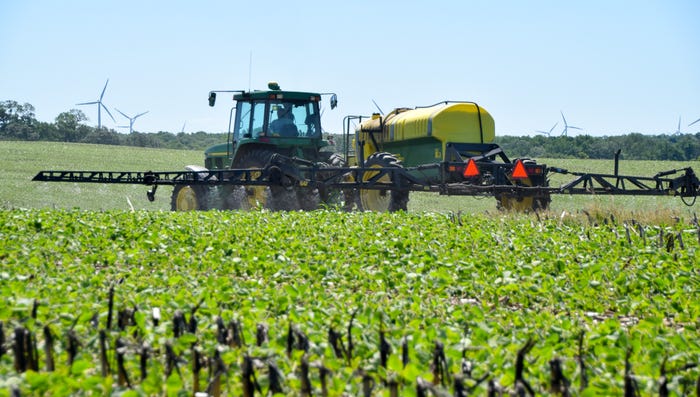June 23, 2017

By Matthew Wilde, ISA senior writer
Farmers are urged to exercise proper chemistry and trait stewardship in their ongoing battle against herbicide-resistant weeds.
Glyphosate isn’t as effective as it once was to combat waterhemp, giant ragweed, marestail and other yield-robbing pests. Many farmers planted soybeans genetically engineered to tolerate reformulated versions of dicamba and 2, 4-D to kill weeds.
As post-emergent spraying ramps up, agriculture and industry experts say farmers and applicators need to read and follow label instructions of new and existing crop protection products to prevent damage from herbicide drift and other issues.
“Growers are really seeing the value dicamba can bring to their overall weed management system,” said Ryan Rector, Monsanto technology development manager for dicamba. “But with that comes responsibility.”
The February and March editions of the Iowa Soybean Review magazine featured several stories about herbicide resistance and how new biotech traits and chemistries can help farmers have clean fields again. The articles emphasized stewardship to prolong the effectiveness of new products and safe, on-target use.

April Hemmes, Dicamba, field spraying
April Hemmes, an Iowa Soybean Association Board member from Hampton, sprays Roundup Ready 2 Xtend soybeans this week with XtendiMax with VaporGrip. She said herbicide drift isn’t a problem with the product since she follows label instructions.
Monsanto developed the Roundup Ready Xtend Crop System. It includes Roundup Ready 2 Xtend soybeans genetically engineered to tolerate XtendiMax™ with VaporGrip™ Technology, an enhanced dicamba herbicide for pre- and post-emergent over-the-top use, and glyphosate.
Rector said about 20 million acres of Roundup Ready 2 Xtend soybeans were planted in the United States this year. Even though XtendiMax with VaporGrip is a low-volatile formulation of dicamba, drift damage to non-target plants and threatened and endangered species can happen due to rain, wind and temperature inversion.
“Folks really need to understand the label and application requirements to make sure applications are successful,” Rector said.
So far, he said feedback from burndown and pre- and post-emergent use of the new product is overwhelmingly positive.
“We’re hearing a lot of good results from applications and excellent weed control comments with dicamba,” Rector said. “We’re just now getting in the post application season (in Iowa). We’ll see how things play out.”
Here’s several XtendiMax with VaporGrip application requirements intended to minimize potential off-target movement:
•Ammonium sulfate and ammonium-based additives in applications are prohibited.
•Apply .5 pounds per acre for any single, in-crop application.
•Apply a minimum of 10 gallons per acre.
•Don’t apply aerially or if rain is expected within 24 hours.
•Only use approved nozzles and tank-mix partners.
•Spray boom height not to exceed 24 inches above target crop.
•Apply only when wind speed is 3-10 mph.
•Do not exceed 15 mph ground speed during application.
•Don’t apply when wind is blowing toward susceptible crops and maintain the required label buffer to protect sensitive areas.
•Use triple-rinse cleanout procedure.
April Hemmes planted all Roundup Ready 2 Xtend soybeans (350 acres) this year due to herbicide resistance issues. Several neighbors planted them as well, she said.
The Iowa Soybean Association (ISA) Board member from Hampton said she had no issues with her pre-emergent applications of XtendiMax with VaporGrip and plans to do post-emergent spraying this week.
“The soybeans look great,” Hemmes said, noting she is following label instructions. “With the new large droplets tips and good stewardship, I don’t expect any problems. I’ve always had to be careful of drift since I have a neighbor who farms organically.”
A farmer recently contacted ISA Regional Agronomist Matt Hoffman with questions about timing of post-emergent applications of XtendiMax with VaporGrip. The producer was concerned the herbicide couldn’t be used after a certain date.
According to Rector, the chemical can be applied up to and through the R-1 growth stage.
“The application cutoff is not date specific,” he said. “When you start to see flowers, you can’t use it anymore. So, scout fields for plant development and keep an eye on weed size. You want to spray when weeds are 4 inches tall or less.”
ISA President Rolland Schnell of Newton said herbicide drift damaged the outside rows of corn on a few farms of a friend.
“Regardless of the type of herbicide used, applicators need to spray with care,” Schnell said.
Several resources are available for farmers and applicators using XtendiMax with VaporGrip:
•xtendimaxapplicationrequirements.com. It contains the latest information on approved nozzles, tank mixes and rules.
•Monsanto field engagement specialists can be reached at 1-844-rr-xtend (1-844-779-8363).
•Local agronomists, crop input suppliers and Iowa State University Extension and Outreach experts are available to answer questions as well.
“There are a lot of resources and experts available as we get in the post application season,” Rector said.
Dicamba drift has been an issue in some southern states. Multiple ag media outlets report there’s been several complaints filed in Tennessee and more the 100 in Arkansas, concerning damage to non-dicamba tolerant soybeans.
According to Agri-Pulse, the Arkansas State Plant Board will vote again Friday on a recommendation to ban the use of dicamba in the state for the rest of the growing season.
Iowa Secretary of Agriculture Bill Northey issued a statement last month urging chemical applicators to take the necessary steps to prevent damage from chemical drift. The Iowa Department of Agriculture and Land Stewardship’s (IDALS) Pesticide Bureau is responsible for responding to complaints and investigating potential misuse of pesticides.
IDALS has partnered with FieldWatch™, Inc. to provide online registry tools — www.iowaagriculture.gov/Horticulture_and_FarmersMarkets/sensitiveCropDirectory.asp — to promote communication between producers of pesticide-sensitive crops, beekeepers and applicators.
“Pesticides, whether herbicides, insecticide or fungicides, are important tools that help keep our crops healthy,” Northey said. “However, it is critically important these products are used appropriately and do not impact neighbors.”
You May Also Like




